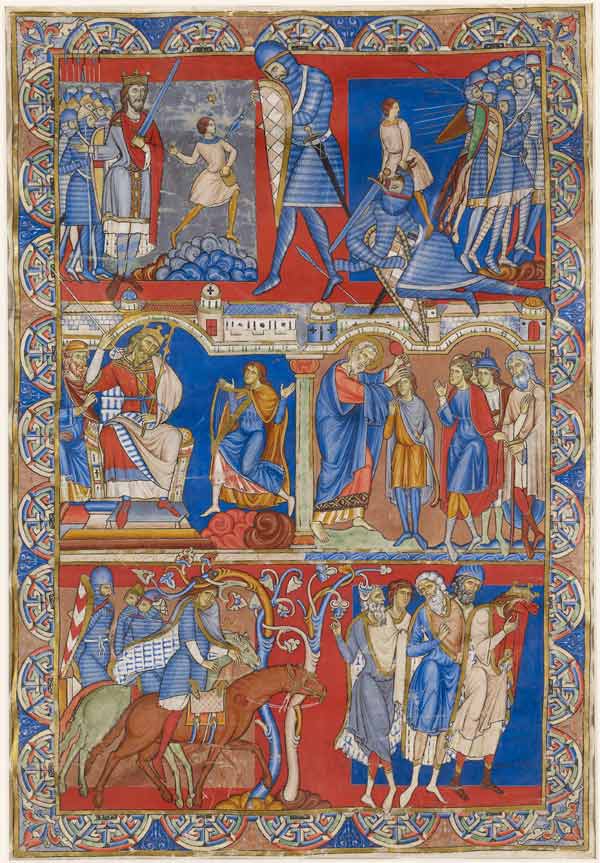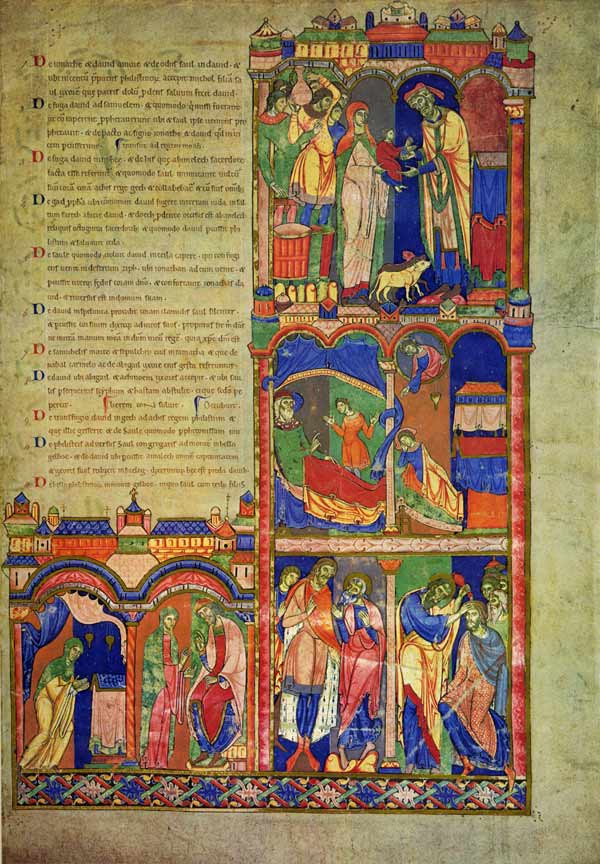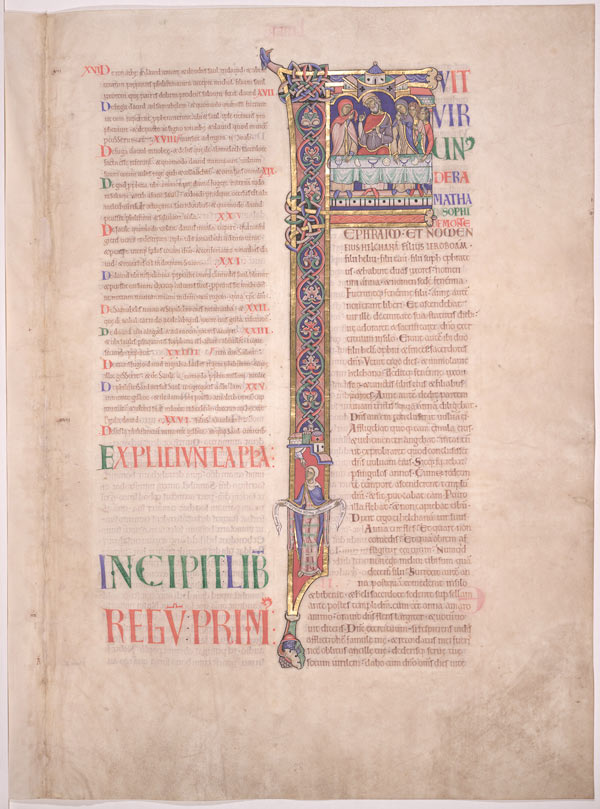The Morgan Leaf, from the Winchester Bible: Frontispiece for 1 Samuel with Life of David (v.), ca. 1150–80. Made in Winchester, England. Tempera and gold on parchment; 22 15/16 x 15 9/16 in. (58.3 x 39.6 cm). Lent by the J. Pierpont Morgan Library and Museum, New York
The Morgan Leaf (pictured above) was the last and greatest single leaf acquired by financier John Pierpont Morgan (1837–1913). (Morgan's collection later became the Morgan Library and Museum.) The twelfth-century Winchester Bible, the largest and finest English Romanesque Bible, on view at the Met through March 8, was begun in around 1160, but was never finished. Although full-page miniatures were not originally planned for the Bible, drawings for four of them were made. Only two were finished: those on the Morgan Leaf.
The Morgan Leaf, from the Winchester Bible: Opening for the Book of 1 Samuel (r.); Frontispiece for 1 Samuel(?) with Life of David (v.), ca 1150–80. Made in Winchester, England. Tempera and gold on parchment; 22 15/16 x 15 9/16 in. (58.3 x 39.6 cm). Lent by the J. Pierpont Morgan Library and Museum, New York
The Morgan Leaf was probably removed from the Bible in 1820. At this time the manuscript was rebound into three volumes and the new numbering for the folios did not include the leaf. According to William Morris's secretary, Sydney Cockerell, the Florentine dealer Leo Olschki offered Morris (the celebrated English designer and promoter of medievalism who died in 1896) the leaf for £100 (date unknown), but he could not afford to buy it. Subsequently, it was offered and sold to Morgan in 1912 for 30,000 francs.
According to Olschki's letter of April 10, 1912, to Morgan's librarian, Belle da Costa Greene, Morgan had visited Olschki the previous day and purchased a "large twelfth-century illuminated leaf (both sides illuminated)" on the spot. The framed leaf was shipped on the SS Principe di Piemonte out of Genoa, Italy. The invoice made no claim as to the country of origin, however; in an early Morgan accession book, where the leaf had the number M.513, it was described as "Italian?, XII century."
In 1926, the British Museum's Keeper of Manuscripts Eric Millar first recognized the leaf's connection with two of the artists of the Winchester Bible, but he did not propose that it had once part of that celebrated manuscript. The Morgan's publications were also cautious, pointing out that the capituli, or chapter headings, for the Book of Samuel were not lacking in the Bible. Later it was suggested that the leaf was "probably" created for the Winchester Bible.
Today, the conclusion that the leaf belonged to the Bible seems inescapable. The argument is based on the fact that the underdrawings on the leaf are by the Master of the Apocrypha Drawings, who also did the other two full-page drawings still preserved in the manuscript (but not colored). The presumably younger collaborator, nicknamed by art historian Walter Oakeshott as the Master of the Morgan Leaf, was responsible for the illumination of the David scenes, clearly his masterpiece. Here the Master of the Morgan Leaf exhibits his own bold and advanced style. He chose monumentality and emotion over detail. He reduced, for example, the number of feet of both horses and men in the bottom tier, and the scene showing David mourning the death of Absalom, his beloved son, must rank as one of the most moving medieval depictions of grief (see the image of the Morgan Leaf at the top of this blog).
One of the most remarkable and telling features of the leaf is the incredible difference between its two sides. On the recto (the page designed to be read first), the underdrawings for the Samuel scenes were closely followed, and the color scheme is more old-fashioned, in greens and oranges. The other side, the David scenes, has a rich and dramatic palette of blues and reds and greater emotional emphasis, revealing an extraordinary transition, on a single leaf, from a Romanesque to a more Gothic style and spirit.
The Morgan Leaf would have preceded folio eighty-eight in the manuscript. The historiated initial is also by the Master of the Morgan Leaf, but it too is over a drawing by the Apocrypha Master. The initial F (of the latin Fuit) depicts Elkanah at dinner with his two wives, the fruitful Penninah and the barren Hannah. At the bottom of the initial, Hannah sings her canticle of thanks for Samuel.
The Winchester Bible: Opening for the Book of 2 Samuel (Book of Kings): Factum (99v), ca. 1150–80. Made in Winchester, England. Tempera and gold on parchment; 23 9/16 × 16 9/16 × 2 3/8 in. (59.9 × 42.1 × 6.1 cm). Opening: 23 9/16 × 27 1/2 in. (59.9 × 69.9 cm). Lent by the Chapter of Winchester Cathedral
Ironically, even if William Morris had purchased the leaf, it would still have ended up in the Morgan Library. In 1902 Morgan purchased the collection of Richard Bennett, who had purchased the Morris collection in 1897.


